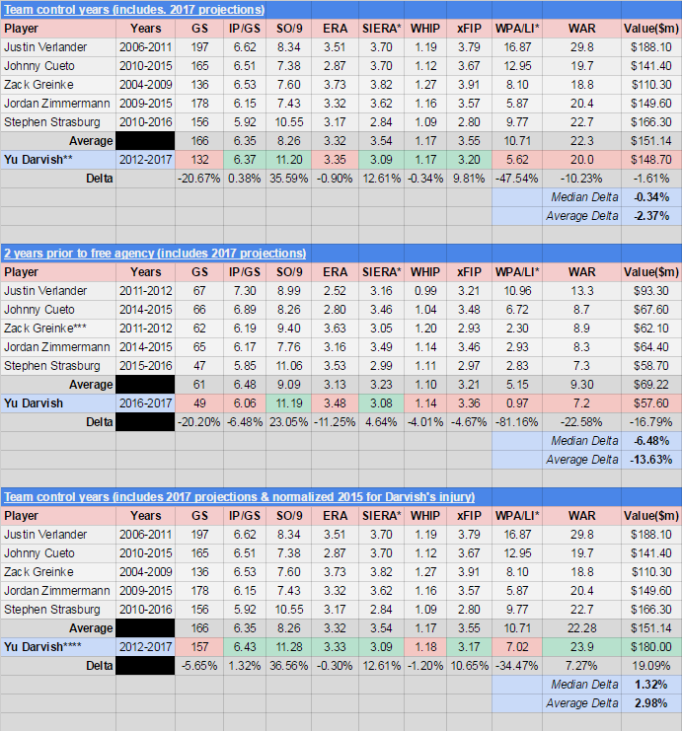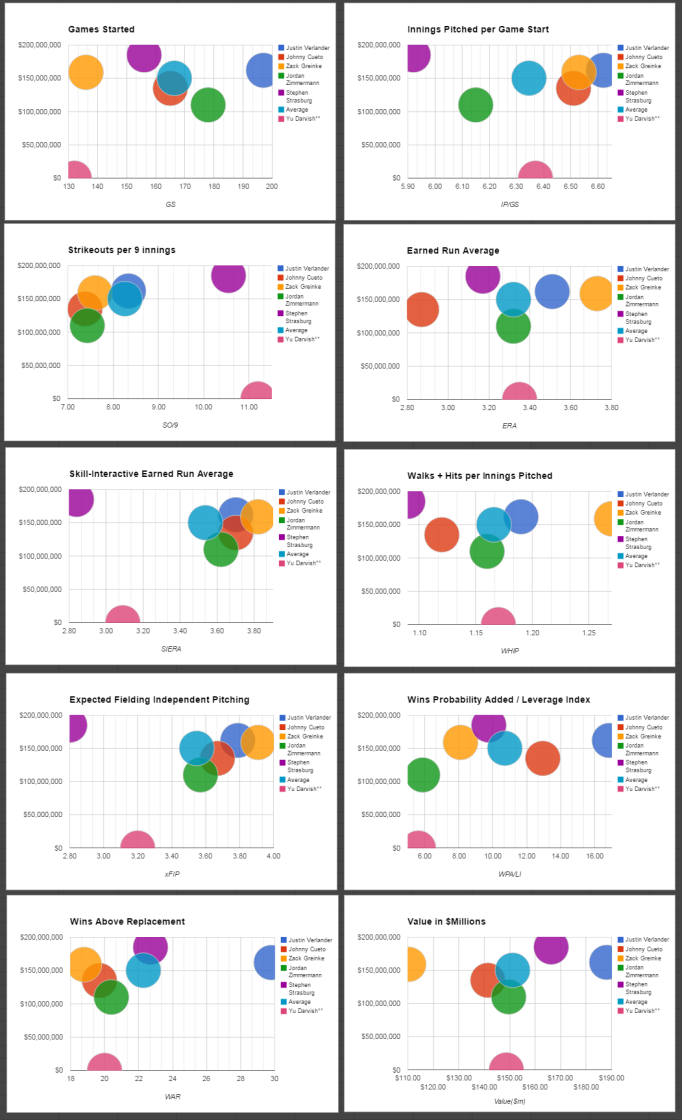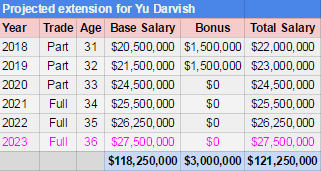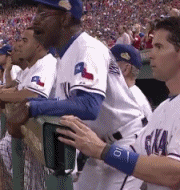
With the ever looming final year in Yu’s contract coming to a close, I will take a look into projecting what it will take to extend Yu Darvish. I will have a follow up article to define how it will be possible, and what the Rangers can do in order to secure Yu for the foreseeable future.
Performance Evaluation
Yu should be able to command somewhere in the range of $24m-$28m a year, and I believe it to be a stretch to think he can get around 30m a year. I’ve followed a similar regression model to that of Spotrac in analyzing similar pitchers by performance and contract to determine a fair market contract for Yu. I did not include Clayton Kershaw, Max Scherzer or David Price as they were in an upper echelon of pre-free agency standards. The players included in the analysis are Justin Verlander, Johnny Cueto, Zack Greinke, Jordan Zimmermann, Stephen Strasburg & Jake Arrieta. Arrieta is actually in the same boat as Yu and is looking at a big pay-day, however, the others have already made their deals so we won’t be able to compare money to Arrieta.
The free agent valuation process is a lot different than valuation for players eligible for arbitration. Bean counter statistics like games played/started, plate appearances, and innings pitched still play a factor in valuation, but I want more granularity to the evaluation. I’m sure players and their agents would do the same in order to prove their client’s worth. The set I derived is GS, IP/GS, SO/9, ERA, SIERA, WHIP, xFIP, WPA/LI, & WAR. I’ve also included value (salary minus WAR multiplied by market value(~$8m)) but simply for reference only. I did not include value into my calculations for Yu’s extension since past value and future value do not correlate in pre-free agency. Some of the stats are fairly well known, but I want to discuss a few that might not be and why I felt it was important to include them.
- xFIP – FIP is a good start when determining a pitcher’s expected run prevention independent of the performance of their defense (SO, HR, BB). However, xFIP normalizes FIP a bit more by tweaking the HR factor in this stat to account for a pitchers fly ball % multiplied by the league’s HR average on fly balls. This stat removes any random artifacts and is a bit more normalized to mean than FIP.
- SIERA – SIERA takes FIP/xFIP to the next level in attempting to model how a pitcher is successful and attempts to better describe balls in play. It’s actually a lot more complicated than my pathetic description but is very intricate and better models how skillful a pitcher actually is compared to normal ratios.
- WPA/LI – WPA/LI is also a good stat to look at when determining skill of a pitcher. WPA (Wins Probability Added) is meant to capture a window of Wins Expentancy for a certain situation a player is in and either credits or debits a player WPA for succeeding or failing in the situation. LI (Leverage Index) is meant to quantify pressure situations a player is involved in to determine if a player is typically used in low or high-leverage situations. By dividing WPA by LI we get a value that quantifies value added by a player regardless of low or high-leverage use.

* Normalized projections for SIERA and WPA/LI were used for 2017 as they are not projected stats by steamer
** Includes 2015 season in which Darvish did not pitch and projected 2017 stats via steamer
*** Stats used prior to first actual free agent contract signing for Greinke (not in arb)
**** Normalized stats used to project 2015 stats for Darvish
I split them into 3 charts. The top one depicts performance over the 6 year team control window, which includes 2015 in which Yu did not pitch as well as projected 2017 stats for Yu via steamer. In the second, I wanted to display the prior 2 years to free agency which include more 2017 projections for Yu via steamer. The final depicts what the first could have looked like if Yu would have pitched in 2015 using normalized statistics derived from each season’s stats.
Contract Term
Unfortunately, for Yu, teams will not take a ‘what if’ scenario into account and will look at Yu’s body of work as is. So we must refer to the first and second chart for reference. The second chart looks fairly bleak, and that is mainly due in part because it still took Yu some time in 2016 to come back from TJ surgery and was only available for 17 games which will hurt his payday projection a bit. With this analysis in place already, we can tell that this pack compares quite well to Yu’s body of work in the MLB with only a 2.75% average delta. The main area concern, is games started, and this will certainly factor into a contract projection. There is also some concern over WPA/LI as we see that Yu’s performance hasn’t been quite as impactful as the others viewed in this demonstration. So let’s get down to brass tacks and talk money.

Here are the contracts each of the players signed when they hit free agency. The first projection we can make is length of contract. For this comparison, the average age when their new contract was signed was 29 years of age. Yu will be 31, and most likely will eliminate at least a year in difference from the average length of the contract which is 6 years. It appears most teams targeted the contract length to end when the pitcher reached 35 years of age. The projected length would be 4-5 years, however I believe a team will have a hard time getting Yu on board with a 4 year term. We will project both terms to give an idea, they will likely be around the same average annual salary. The above originally did not entail signing bonus, but I decided to include it as that contributes to a players overall salary. We have an average of $150.2m contract size with an average annual salary of $24.885m per year.
Contract Value
So let’s determine how much Yu should be paid over this time period. We will plot out each of the stats observed in the first chart above and attempt to pinpoint the exact range we can expect Yu to rake in. My earliest guesstimate would be $120m-$124m for 5 years or $92m-$96m for 4 years. But, let’s take a look at the scatter charts and go from there.

Yu is the pink bubble at the bottom since we don’t have a dollar amount for him in the analysis, we can move his bubble up toward the closest ones it intersects and get a mean from there. Excluding the last graph value, we get a mean dollar amount for all of the junctions of $149.333m. Now this value is not normalized due to variance in years, and if we look strictly at average annual salary instead, we get close to $24.24m per year. The discrepancy at hand, is of course Yu’s age. A $149.333m contract with about a $24.888m average per year would yield a 6 year term. As mentioned previously, Yu will most likely be getting closer to a 4 or 5 year term and I’d highly doubt that he would get a Scherzer like contract due to his injury history.
With this analysis in place we have enough data to project what Yu will earn. Yu’s new contract should be in the range of a 5 year deal worth around $121.2m. And the other eligible player in this exercise, Arrieta, is looking at the same term length of a 5 year deal worth a nudge more than Yu’s contract coming in at $125.635m.
So the outcome of the projection is currently sitting at a 5 year deal for $121.2m yielding an average annual salary of $24.24m per year. This makes a 4 year pact a total of $96.96m. None of these figures include incentives which will increase his earning potential and I’m certain will be required to sign Yu. We are talking about the basics that he already has included in his current contract. All-Star selection, Gold Glove, LCS/WS MVP , AL MVP , Cy Young and will most likely include possibly a vesting option for a 6th year and/or bonuses for IP in his final couple years of his contract or a combination of both similar to the Cole Hamel’s contract. This gives the Rangers some protection against injury of about $5m-$20m of guaranteed money on the new contract, and instead incentivizes Yu’s performance which is a Win-Win. After review, here is how his contract would be configured:

- Signing Bonus: $3,000,000 split between 2018 and 2019 season.
- Partial no-trade clause from 2018-2019 from 10 team trade approved list.
- Full no-trade clause from 2020-2022(2023).
- Trade Assignment Bonus of $2,000,000.
- Mutual option for a 6th year – automatically vests if finished in the top 5 of Cy Young voting in 2022 and not on the DL at the end of 2022 season with a shoulder or elbow injury. (Player opt-out deadline is 24 hours after the final game of the World Series, team opt-out deadline is 48 hours after the final game of the World Series).
- If mutual option for 6th year does not automatically vests the club may decide to opt-out of contract for a buyout of $5,000,000. The player will not receive additional money if they decide to opt-out of contract.
- All-Star Selection, Gold Glove, Silver Slugger incentives: $100,000
- LCS MVP: $150,000
- WS MVP: $250,000
- AL/NL MVP: $500,000
- Cy Young: $500,000 (2nd: $250,000, 3rd: $150,000, 4th: $100,000, 5th: $50,000)
This is how I would structure the contract. The contract does not have a player only or team only opt-out, but would include a mutual option for a 6th year and would automatically vest if Yu finishes in the top 5 of Cy Young voting. The contract is packed with performance incentives and is back-loaded so the front office has time to plan around this contract.
Outcome – Cause & Effect
Immediately the Ranger’s will be down around another $11m for 2018 once Yu’s extention is signed and slightly increase each year after that. However, this locks in one of the games elite pitchers in the MLB to a team he might be more inclined to continue playing for as the level of comfort has already been established being foreign to this country. This also gives the Rangers a big name to showcase as they enter into the new stadium no later than the 2021 season.
This is all great stuff, but of course with any big contract or player, there is obviously a margin of error. An area I don’t consider myself knowledgeable in is the area of projecting the health or even the performance of a player over an extended period of 5 years. The game has changed so much over the last 10 years in terms of pitcher health, training and longevity, that to conduct a regression analysis would be a foolishly bleak attempt in establishing some sort of accurate correlation. I’m sure this makes it extremely difficult for clubs to determine if a player will project in their favor according to health and performance rate. Ranger fans should still have a sour taste in their mouth from this season’s tragic end to Prince Fielder’s playing career to be all too familiar with the uncertainty of a player’s health projection. It’s a dice any club has to be willing to roll while attempting to mitigate failure points as best as possible.
It would also be very intriguing to have a top of the rotation of Yu & Shohei Otani. They are mentioned to be close, and workout partners. Otani does not have free will in the matter of selecting the team he will go to but I’m sure Yu wouldn’t mind playing with a familiar friend in a foreign land. Just something else to day dream about.
In closing, the Rangers would be ill-fated if they did not at least try to work out an extension for Yu that is reasonable. Yu’s value has taken a hit from his TJ surgery and 2015 absence, and this increases the chances the Rangers have at signing him as it essentially decreases the overall guaranteed money in a projected extension. If Yu and the Rangers are too far apart, that wouldn’t be a surprise but I believe what I presented here would be a reasonably fair contract for his body of work in the major leagues and would give the Rangers a ton of value if Yu stays healthy over the term.
Here is to hoping the Rangers can get it done…

[…] to the club who all voice this concern, one of the main ones being budget. To assist in this area, I created an analysis to project what Yu should command on the open market in an earlier article. Another issue expressed […]
LikeLike